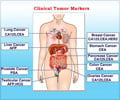Injecting activators of tumor suppressors could increase tumor destruction and decrease toxicity for cancer treatment, finds a study.
Highlights
- Cancerous tumors occur due to the abnormal proliferation of cells.
- Injecting an agent that activates tumor suppressor could enhance tumor destruction and decrease toxicity.
- Further research will help to improve the therapeutic potential approach for cancer.
The direct drug delivery also helps to reduce toxic side effects that include the destruction of healthy blood and immune cells.
Cui said, "It’s not a matter of not having drugs, it’s a matter of how we can better utilize the drugs."
Gene p53
The p53 gene which is inactive when we are healthy is also called as a gatekeeper and caretaker because of the protective role it plays when our bodies are challenged, Cui said.
The gene levels could also increase in response to stressors such as DNA damage caused due to environmental exposures like ultraviolet rays from the sun, cancer treatments like chemotherapy, reactive oxygen species that could pile up as our cells use oxygen.
Cells under stress would stop the excessive proliferation due to increase levels and result in cancer hallmark. This could either finish repairing the DNA damage or die as a natural process called apoptosis.
"If it’s not functional, you can imagine, we accumulate errors in cells and that is why we develop cancer."
Cancer can also alter p53 for its own purposes as with many natural functions. Around half of them have normal p53 and the other half have an altered version that could support them.
If the p53 gene could not help correct or eliminate the stressed cells, the gene could change so that it promotes the chronic inflammation which could fuel cancer. Instead of correcting or killing the cells altered p53 gene could help cancer to evade the immune attack.
Nutlin-3a to Activate p53 Gene
When an agent like nutlin-3a is used in studies in models of lymphoma and melanoma may work to activate more of the normal p53 by suppressing the natural p53 inhibitor which could be overexpressed in many tumors.
Early Clinical Trials
The results of the early clinical trials were found to be disappointing. When given systematically, it could result in toxic effects like suppressing the bone marrow so that the patient becomes anemic or worse as well as to kill the potentially helpful immune cells.
Research Study
The research team injected nutlin-3a directly to the tumor and watched as p53 got activated and immune cells began moving to the area. The scientists observed the activity of the immune cells that were educated on what to attack and also found that it could move out of the primary tumor site to other areas of the body where it traveled.
The direct injection of the agent could create a pocket of immune activation.
"You bring the immune activators in, they clean up the (cancer) cells and that activates T cells, which are really the soldiers that will go out and kill additional tumors. We can see the tumor shrink in the mice."
This strategy also ensured that there were sufficient number of immune cells for attack. The lymphoma model was also found to have sufficient immune cells that were already inside the tumor however measures showed low levels in melanoma model.
The scientists, therefore, gave poly-IC, a synthetic version of double-stranded RNA, which the body could associate with viral infection and send immune cells in to respond.
The research team was able to show how poly-IC could improve the effectiveness of therapeutic cancer vaccines and could produce a vigorous T cell response. Poly-IC was also found to significantly strengthen the attack and tumor control.
Further steps include adding mixture of drugs to restore normal p53 in tumors with already altered versions. This could improve the therapeutic potential approach.
Source-Medindia
















